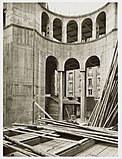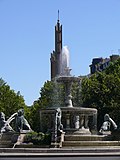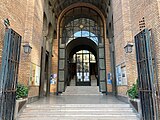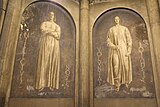
The Basilica of Sacré Coeur de Montmartre, commonly known as Sacré-Cœur Basilica and often simply Sacré-Cœur, is a Catholic church and minor basilica in Paris dedicated to the Sacred Heart of Jesus. It was formally approved as a national historic monument by the National Commission of Patrimony and Architecture on December 8, 2022.

The Church of St. Eustache, Paris, is a church in the 1st arrondissement of Paris. The present building was built between 1532 and 1633.

The Église de la Sainte-Trinité is a Roman Catholic church located on the place d'Estienne d'Orves, at 3 rue de la Trinité, in the 9th arrondissement of Paris. It was built between 1861 and 1867 during the reign of Emperor Napoleon III, in the residential neighborhood of the Chaussée d'Antin. It is in the ornate Neo-Renaissance or Second Empire Style, with a highly visible 65-meter-tall belfry.

The Basilica of Saint Clotilde is a basilica church located on the Rue Las Cases, in the 7th arrondissement of Paris. It was constructed between 1846 and 1856, and is the first example of a church in Paris in the neo-Gothic style.

Saint-Louis en l'Île is a Roman Catholic parish church located at 19 Rue Saint-Louis en l'Île on Île Saint-Louis in the 4th arrondissement of Paris, France. It was constructed between 1664 and 1725, and is dedicated to King Louis IX of France, or Saint Louis. The church was originally built in the French Baroque style of the 17th century, but much of the interior decoration was taken or destroyed in the French Revolution. The church was extensively restored and redecorated in the 19th century.

The Église Saint-Augustin de Paris is a Catholic church located at 46 boulevard Malesherbes in the 8th arrondissement of Paris. The church was built between 1860 and 1871 by the Paris city chief architect Victor Baltard. It was the first church in Paris to combine a cast-iron frame, fully visible, with stone construction. It was designed to provide a prominent landmark at the junction of two new boulevards built during Haussmann's renovation of Paris under Napoleon III. The closest métro station is Saint-Augustin

Saint-Jean de Montmartre is a Roman Catholic parish church located at 19 Rue des Abbesses in the 18th arrondissement of Paris.
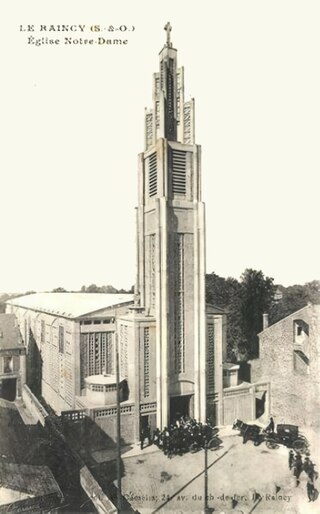
The Église Notre-Dame du Raincy is a Roman Catholic church in the commune of Le Raincy near Paris. It was built in 1922-23 by the French architects Auguste Perret and Gustave Perret. The edifice is considered a monument of modernism in architecture, using reinforced concrete in a manner that expresses the possibilities of the new material.

The Church of the Val-de-Grâce is a Roman Catholic church in the 5th arrondissement of Paris. The church was built as part of a royal abbey by Anne of Austria, the Queen of France, to celebrate the birth of her son, Louis XIV in 1638. Construction began in 1645 under the direction of architect François Mansart and was completed in 1665 by Gabriel Le Duc. The abbey and church were turned into a hospital during the French Revolution and then became part of the Val-de-Grâce Hospital, which closed in 1979. The church is attached to the diocese of the French military and is open to visitors at specified hours. Its dome is a landmark in the skyline of Paris.

The Église Saint-Paul-Saint-Louis is a church on rue Saint-Antoine in the Marais quarter of Paris. The present building was constructed from 1627 to '41 by the Jesuit architects Étienne Martellange and François Derand, on the orders of Louis XIII of France. It was the first church in Paris to break away entirely from the Gothic style and to use the new Baroque style of the Jesuits, and it had an important influence on Parisian religious architecture. It gives its name to Place Saint-Paul and its nearest Metro station, Saint-Paul. Next door to the church is the Lycée Charlemagne, also founded by the Jesuits.

Église Saint-Joseph-des-Carmes (Saint-Joseph-des-Carmes) is a Roman Catholic church located at 70 rue de Vaugirard in the 6th arrondissement of Paris. It was originally built as the chapel of a convent of the mendicant order of Shoeless Carmelites. It is now the church of the Catholic Institute of Paris, a university-level seminary for training priests, and is also a parish church for the neighbourhood. It is dedicated to Saint Joseph, husband of the Virgin Mary. Built between 1613 and 1620, it combines elements of Classical architecture on the exterior with a remarkable display of Baroque architecture and art in the interior. The chapel is open to the public at limited hours.

Saint-Thomas-d'Aquin is a Roman Catholic church located in the 7th arrondissement of Paris, place Saint-Thomas-d’Aquin, between the rue du Bac and the boulevard Saint-Germain. The church is named for Saint Thomas Aquinas, a Dominican friar and priest, and influential philosopher and theologian in the 13th century. It was originally a chapel of an abbey of the Dominican order in Paris. Construction began in 1682, and the church was consecrated in 1682. The friars were expelled and the church was closed during the French Revolution, and was not returned to the Catholic church until 1802. During the 19th century, the City of Paris endowed the church with many fine examples of French religious art. The church was declared an Historic Monument in 1982.
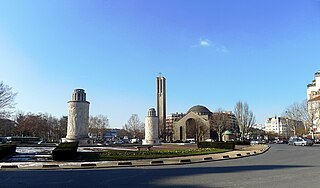
Sainte-Jeanne-de-Chantal is a Catholic church in Paris built of concrete in Byzantine style with a large dome. It was constructed between 1932 and 1956.

Saint-Pierre de Chaillot is a Roman Catholic parish church in the Chaillot neighborhood of the 16th arrondissement of Paris, at 31, avenue Marceau. It is constructed in the "Romano-Byzantine" style.

Église Saint-Eugène-Sainte-Cécile is a Roman Catholic church located at 6 rue Sainte-Cécile in the 9th arrondissement of Paris. In 1983 it was designated as a monument historique in its entirety. Designed in the Neo-Gothic style by Louis-Auguste Boileau and Louis-Adrien Lusson, the church was the first in France to use an entirely iron-framed construction. The first stone was laid in 1854, and the building was completed in 1855.
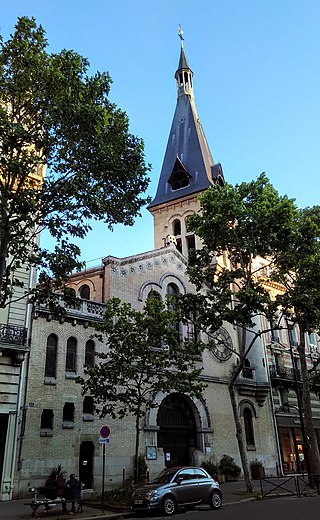
Saint-Antoine des Quinze-Vingts is a Roman Catholic parish church located at 66 Avenue Ledru Rollin in the 12th arrondissement of Paris.

The Church of Saint-Jean-Bosco is a Roman Catholic church located at 79 rue Alexandre-Dumas in the 20th arrondissement of Paris. Built between 1933 and 1938, it is a rare example of a Paris church in the Art Deco style. It takes its name from Saint John Bosco (1815–1880), an Italian Catholic priest who founded the order of the Salesians of Don Bosco, and devoted his career to promoting education for working-class children, both boys and girls. All of the paintings, murals, stained glass, mosaics, statues and architecture were created within a decade, giving them a harmonious Art Deco style. It was designated as a French national historic monument in 2001.

Sainte-Odile is a Roman Catholic church located in the 17th arrondissement of Paris, at the northwest edge of the city. It is dedicated to Saint Odile, the patron saint of Alsace. It was constructed between 1935 and 1946, and is a rare example of Art Deco architecture among the churches of Paris. Its bell tower, 72 meters high, is the tallest in Paris. It is also known for its remarkable collection of Art Deco stained-glass windows. It was classified as French historic monument in 2001.
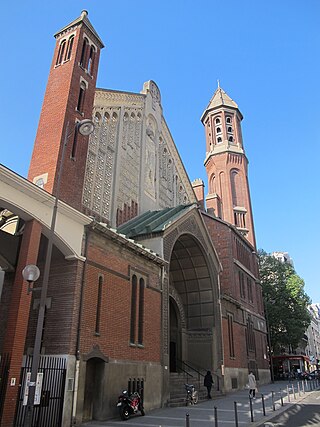
Saint-Christophe-de-Javel is a Roman-Catholic church located at 4 rue Saint-Christophe in the 15th arrondissement of Paris. It was constructed between 1926 and 1930 in the newly industrialized neighborhood of Paris by the architect Charles-Henri Besnard (1881-1946), a follower of the architect and historian Viollet-le-Duc. While the church architecture is inspired by the Gothic architecture of the 13th century, it was constructed using a modern material, reinforced concrete, and made an innovative use of molded cement for the decoration of the facade and interior.

Notre-Dame de la Gare is a Roman Catholic parish church located on Place Jeanne-d'Arc in the 13th arrondissement of Paris, France. It was built between 1855 and 1864 in an area of Paris which was rapidly industrializing, and was located near the major freight railway station, or "Gare", which gave the church its name. The style was inspired by Romanesque architecture.






